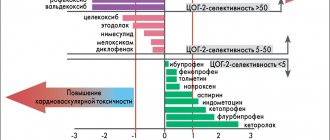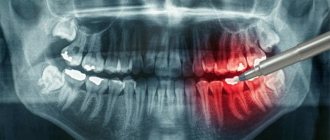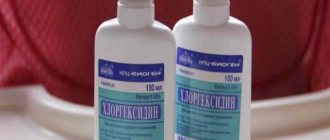Nimesulide
Undesirable side effects can be minimized by using the drug in the minimum effective dose with the minimum duration of use necessary to relieve pain.
There is evidence of very rare cases of serious reactions from the liver, including cases of death, associated with the use of nimesulide-containing drugs. If symptoms similar to signs of liver damage appear (anorexia, itching, yellowing of the skin, nausea, vomiting, abdominal pain, dark urine, increased activity of liver transaminases), you should immediately stop using the drug Nimesulide and consult a doctor. Repeated use of Nimesulide in such patients is contraindicated.
Reactions from the liver, in most cases of a reverse nature, have been reported with short-term use of the drug.
While using the drug Nimesulide, the patient should refrain from taking other analgesics, including NSAIDs (including selective COX-2 inhibitors).
The drug Nimesulide should be used with caution in patients with a history of gastrointestinal diseases (ulcerative colitis, Crohn's disease), since exacerbation of these diseases is possible.
The risk of gastrointestinal bleeding, peptic ulcer/perforation of the stomach or duodenum increases in patients with a history of gastrointestinal ulceration (ulcerative colitis, Crohn's disease), as well as in elderly patients, with an increase in the dose of NSAIDs, so treatment should begin with the lowest possible dose. In such patients, as well as in patients who require the simultaneous use of low doses of acetylsalicylic acid or other drugs that increase the risk of complications from the gastrointestinal tract, it is recommended to additionally prescribe gastroprotectors (misoprostol or proton pump blockers).
Patients with a history of gastrointestinal disease, especially older patients, should report new gastrointestinal symptoms (especially symptoms that may indicate possible gastrointestinal bleeding) to their physician.
Nimesulide should be administered with caution to patients taking drugs that increase the risk of ulceration or bleeding (oral corticosteroids, anticoagulants such as warfarin, selective serotonin reuptake inhibitors or antiplatelet agents such as acetylsalicylic acid).
If gastrointestinal bleeding or gastrointestinal ulceration occurs in patients taking Nimesulide, treatment with the drug must be stopped immediately.
Given reports of visual impairment in patients taking other NSAIDs, if any visual impairment occurs, use of Nimesulide should be immediately discontinued and an ophthalmological examination performed.
The drug may cause fluid retention, therefore, in patients with arterial hypertension, renal and/or heart failure, Nimesulide should be used with extreme caution. If the condition worsens, treatment with Nimesulide should be discontinued.
Clinical studies and epidemiological data suggest that NSAIDs, especially at high doses and with long-term use, may lead to a small risk of myocardial infarction or stroke. There is insufficient data to exclude the risk of such events when using nimesulide.
The drug may cause fluid retention in the body.
Patients with arterial hypertension, renal and/or heart failure, coronary heart disease, peripheral arterial disease and/or cerebrovascular diseases, with risk factors for the development of cardiovascular diseases (for example: hyperlipidemia, in smokers), Nimesulide should be used with caution. . If the condition worsens, treatment with Nimesulide should be discontinued.
If signs of a “cold” or acute respiratory viral infection occur while using the drug Nimesulide, the drug should be discontinued.
Nimesulide can change the properties of platelets, so caution must be exercised when using the drug in people with hemorrhagic diathesis, however, the drug does not replace the preventive effect of acetylsalicylic acid in cardiovascular diseases.
Elderly patients are especially susceptible to adverse reactions to NSAIDs, including the risk of life-threatening gastrointestinal bleeding and perforation, and decreased renal, hepatic, and cardiac function. When taking the drug Nimesulide for this category of patients, proper clinical monitoring is necessary.
There is evidence of rare cases of skin reactions (such as exfoliative dermatitis, Stevens-Johnson syndrome, toxic epidermal necrolysis) when taking NSAIDs, including nimesulide. At the first manifestations of a skin rash, damage to the mucous membranes or other signs of an allergic reaction, Nimesulide should be stopped immediately.
Long-term use of nimesulide in real clinical practice: safety issues
Nonsteroidal anti-inflammatory drugs (NSAIDs) are the most commonly used drugs in real clinical practice. The combination of analgesic, anti-inflammatory and antipyretic effects has led to the demand for these drugs in the treatment of a large number of diseases. At the same time, NSAIDs occupy a different place in the treatment of different nosological forms. For a number of diseases, NSAIDs are primarily symptomatic agents (for example, for cancer), although in fairness it should be noted that a number of NSAIDs (for example, nimesulide and celecoxib) have the ability to slow down neoangiogenesis and inhibit tumor growth [1]. For acute pain in the spine, anti-inflammatory drugs, along with analgesics, are used in short courses until the pain syndrome and local inflammation decrease. A number of studies have shown that simple analgesics (paracetamol) have a comparable or lesser analgesic effect than NSAIDs in this category of patients [2]. There are diseases for which NSAIDs are considered disease-modifying (disease-modifying) drugs. Such diseases include spondyloarthritis (SpA). SpA is a group of systemic inflammatory diseases, which are characterized by frequent involvement of the sacroiliac joints and spine in the inflammatory process, the presence of peripheral mono- or oligoarthritis, seronegativity for rheumatoid factor, absence of rheumatoid nodules, family cases of the disease, association with the HLA-B27 antigen, frequent development of enthesitis, typical extra-articular manifestations (uveitis, damage to the skin and mucous membranes, inflammatory bowel diseases, etc.) [3]. According to some studies, NSAIDs are drugs, the use of which inhibits the progression of the formation of syndesmophytes in patients with SpA, and this positive effect is directly related to the NSAID consumption index, which reflects the frequency and duration of taking a particular drug in this group [4]. NSAIDs, according to the recommendations of the International Society for the Assessment of Spondyloarthritis - ASAS/EULAR (the Assessment of Spondyloarthritis International Society/European Lique Against Rheumatism), are first-line drugs in the treatment of axial SpA in the presence of pain and stiffness. Moreover, long-term use of NSAIDs is indicated for patients with persistent activity and persistence of symptoms of the disease. When prescribing NSAIDs, the risk of cardiovascular, gastrointestinal and renal pathologies should be taken into account [5]. Adverse events associated with taking NSAIDs, of which the most significant are ulcerogenic, hepato- and nephrotoxic effects, and the adverse effects of drugs on the cardiovascular system, significantly limit their long-term use [6, 7]. The recommendations of a number of rheumatological societies indicate the use of NSAIDs in minimally effective doses for a short time or recommend their replacement with analgesics [7]. Thus, when it comes to the treatment of patients with SpA, there is some contradiction in the existing recommendations: on the one hand, NSAIDs are disease-modifying drugs for this group of patients and should be used long-term, on the other hand, the possible side effects of NSAIDs make it necessary to take these drugs minimal doses and courses. What are the requirements for an optimal anti-inflammatory drug for the treatment of SpA? Firstly, a rapid anti-inflammatory and analgesic effect that lasts for a long time is necessary. Secondly, the drug must be administered orally and be highly safe. In the population of patients with SpA, the risk of rapid exacerbation of cardiovascular diseases (in particular, heart failure) is less than in other joint diseases (patients are mainly younger than 50 years). At the same time, with long-term use of NSAIDs, this risk may increase [8], which will require a search for the safest drug for therapy in the presence of cardiovascular pathology, as well as monitoring the state of the cardiovascular system. With long-term use of NSAIDs, the risk of gastrointestinal complications increases. It can be reduced by using drugs that are selective or partially selective for cyclooxygenase-2 (COX-2). If the risk of complications is high, you should take a combination of such drugs with a proton pump inhibitor. Prevention of hepato- and nephrotoxic effects with long-term use of NSAIDs seems to be the most difficult task, because these side effects are difficult to predict and may occur in individuals with no history of risk factors [9–13]. In modern clinical practice, one of the most attractive NSAIDs for chronic use is nimesulide (Nise®), an oral drug with a partially selective effect on cyclooxygenase-2 (COX-2), a low risk of complications from the cardiovascular system and minimal hepatotoxicity. - and nephrotoxic effects. Over 28 years of use (since 1985), nimesulide has been studied quite well and has found widespread use in global clinical practice [14]. The drug is used in almost 50 countries around the world. According to the pharmaceutical company Helsinn Healthcare SA, by 2005, about 450 million therapeutic courses of nimesulide were administered worldwide [15–17]. The group studying the effectiveness of nimesulide (Consensus Report Group on Nimesulid, 2006) identified the main advantages of the drug, allowing its use in clinical practice: a high safety profile regarding complications from the gastrointestinal tract (GIT), high cardiovascular safety, pronounced anti-inflammatory and analgesic effect with a rapid onset of action (30 minutes after administration) [15]. These properties of the drug are based not only on the primary suppression of COX-2 activity, but also on effects not associated with suppression of COX activity. These effects lie in the ability of the drug to control pro-inflammatory mediators, the synthesis of which occurs under the influence of 3,5-adenosine monophosphate; in the ability to influence the degranulation of mast cells, reducing the release of histamine and hydrochloric acid from the gastric mucosa. They are also due to the biochemical properties of the drug - the high lipophilicity and alkaline properties of the nimesulide molecule make it difficult to penetrate into the mucous membrane of the upper gastrointestinal tract, excluding contact irritation [15, 16, 18–21]. The maximum daily dose of Nise® is 200 mg. However, it is known that some doctors and patients refuse to use nimesulide due to reports of its negative effect on liver and kidney function [9, 22–24]. In total, about 200 cases of hepatotoxic effects of nimesulide have been described, of which 81 cases were severe. It follows from this that acute liver failure when taking nimesulide is an unpredictable effect of the drug and can develop both with its long-term use and after several doses. However, the overall incidence of adverse events from the liver is low. According to Traversa G. et al. (2003), the frequency of changes in liver function in patients taking NSAIDs in the period from 1997 to 2001 was 29.8 per 100 thousand patient-years (n = 400,000). The relative risk of developing liver pathology when using nimesulide was 1.4 (95% CI; 1.0–2.1) compared with that in patients who did not take NSAIDs for more than 12 months. The incidence of liver damage reached 35.3 per 100 thousand patient-years during treatment with nimesulide, 39.2 with diclofenac, 66.8 with ketorolac and 44.6 with ibuprofen [25]. Thus, the described 200 cases of acute liver damage in 450 million courses of drug use should be considered as a rare effect, which (according to the conclusions of a number of societies for the study of drug safety) cannot be a basis for prohibiting the use of nimesulide in clinical practice. When nimesulide is used, the literature describes a decrease in glomerular filtration rate (GFR) and the development of tubulointerstitial nephritis [9–13]. In the presence of isolated clinical cases of acute kidney injury [9, 23], the overall incidence of renal dysfunction during long-term treatment with nimesulide is unknown. The most dangerous adverse event that determines the mortality of patients using NSAIDs remains gastrointestinal bleeding. Despite preventive measures taken, thousands of cases of new gastrointestinal bleeding associated with NSAID use are reported every year [26]. According to Laporte J. et al. (2004), 401.4 cases of bleeding in the upper gastrointestinal tract were registered per 1 million inhabitants over the age of 18 years. The risk rate of gastrointestinal bleeding with nimesulide was 3.2 (95% CI: 1.9, 5.6), and with meloxicam - 5.7 (95% CI: 2.2, 15.0) [27 ]. A study was carried out at the Institute of Rheumatology of the Russian Academy of Medical Sciences (Moscow) in which 200 mg of nimesulide or 100 mg of diclofenac sodium were prescribed to patients immediately after treatment for gastric ulcer or erosive gastritis. Recurrence of ulcer after 2 months. observations occurred in only 1 patient receiving nimesulide (5.6%) and in 1/3 (33.3%) of patients treated with diclofenac (p <0.05) [17, 28, 29]. It should be noted that due to the rarity of hepato- and nephrotoxic effects and the high safety profile with regard to gastrointestinal and cardiovascular complications, the benefit/risk ratio of nimesulide remains consistently high, despite the reported cases of acute kidney and liver damage. These data were the basis for the conclusion of the Consensus Report Group on Nimesulid (2006), which did not recommend removing the drug from clinical practice. At the same time, it is known that over-the-counter dispensing of nimesulide in the Russian Federation leads to the fact that some patients take the drug in violation of the recommended dosage regimen. Therefore, it seemed interesting to us to analyze the characteristics of taking nimesulide in patients with SpA in real clinical practice with the study of patients’ awareness of the side effects of the drug and safety issues of its use, incl. and in case of violation of the recommended schemes. The purpose of this study was to study the incidence of liver and/or renal dysfunction in patients with axial SpA taking nimesulide (Nise®), and their association with the characteristics of the drug in real clinical practice. Materials and methods The study included 96 patients (18–50 years old) who were treated in the rheumatology department of the regional clinical hospital in Saratov in 2010–2013. The diagnosis of axial SpA was established based on the patient’s compliance with the ASAS (the Assessment of Spondyloarthritis International Society) classification criteria [30, 31]. Patients underwent a general clinical examination, a complete blood count (CBC), a complete urinalysis (UCA), and CRP were examined using a highly sensitive method using Diasis reagents; total protein, albumin, urea, creatinine, glucose, bilirubin, serum aspartate and alanine aminotransferase. In some patients, daily proteinuria was examined, renal ultrasound, and duplex examination of the renal arteries were performed. The presence of hyposthenuria was determined when the specific gravity of morning urine decreased to less than 1018 c.u. against the background of dry eating. GFR was calculated using the MDRD (Modification of Renal Disease Study) formula [32]. SpA activity was determined by calculating the BASDAI index (Bath Ankylosing Spondylitis Disease Activity Index) [29]. The therapy that patients received on an outpatient basis until hospitalization and the recommendations of their attending physicians upon discharge were analyzed. The presence of chronic kidney disease (CKD) was determined based on the recommendations of K/DOQI (2002) [33]. Patients taking nimesulide (Nise®) were provided with a questionnaire specifying the duration, frequency of administration and dosages of the drug used. The study protocol was approved by the ethical committee of the State Budgetary Educational Institution of Higher Professional Education "Saratov State Medical University named after. IN AND. Razumovsky" of the Ministry of Health of the Russian Federation. Statistical processing was carried out using Microsoft Office Excel 2007 (Microsoft Corp., USA) and Statistica 8.0 (StatSoft Inc., USA). The nature of the data distribution was assessed graphically and using the Shapiro-Wilk test. Descriptions of features that have a normal distribution are presented in the form M±SD, where M is the arithmetic mean, SD is the standard deviation; for features with a distribution other than normal, the results are presented in the form Ме [Q1; Q3], where Me is the median, Q1 and Q3 are the 1st and 3rd quartiles. To process data with a normal type of distribution, parametric methods were used: t-test for independent groups, paired t-test. When the data distribution was different from normal, nonparametric methods were used: Mann-Whitney test, Wald-Wolfowitz test, χ2 test, Wilcoxon test, sign test. When comparing more than two independent groups, analysis of variance methods were used: parametric analysis of variance for normally distributed data and Kruskal-Wallis rank analysis of variations for data with a non-normal distribution [34]. Results and discussion The study included 53 patients (men), their average age was 42.3±10.5 years, disease duration was 14.1±8 years (55.2%). Most patients had high disease activity: 85 (88.54%) patients had BASDAI ≥4, CRP – 12.44 [2.2; 26.2] mg/l, ESR – 18 [14; 24] mm/h. All patients noted the presence of inflammatory pain in the back (daily) and used NSAIDs for treatment. Signs of CKD were identified in 77 (80.2%) patients with SpA. A decrease in GFR in the range from 60 to 89 ml/min/1.73 m2 was detected in 39 (40.6%) patients, a decrease from 30 to 59 ml/min/1.73 m2 – in 6 (6.25%). Hyposthenuria was detected in 56 (58.33%), proteinuria – in 36 (37.5%) patients. Arterial hypertension was detected in 30 (31.25%) patients, diabetes mellitus – in 2 (2.08%). According to population studies, the incidence of CKD in the general population is 39% [CI 31; 47] [35] (differences with the incidence of CKD in patients with SpA are significant, p<0.05). The relationship between the degree of reduction in GFR and the activity of SpA has not been established. Consequently, the question arose about the relationship of the identified changes with the use of NSAIDs. The most frequently used NSAID in the examined group was nimesulide – it was taken by 70 (72.92%) patients. The average age of 35 (50%) patients (men) who used nimesulide was 41.43±10.95 years, the duration of the disease was 13.72±9.14 years. When analyzing the nimesulide dosage regimen, it was found that 18 patients had been taking the drug for 6 months. up to 1 year, 12 – from 1 year to 3 years, 22 – more than 3 and less than 10 years, 6 – more than 10 years. 8 patients take the drug in courses of 10 days several times a year, 12 – several times a week, 26 – constantly, 24 patients found it difficult to clarify the dosage regimen (they take it “on demand”). 24 patients usually take 200 mg of the drug per day, 34 – 400 mg/day, 12 – more than 500 mg/day. For severe pain, 18 (25.7%) patients take from 500 to 800 mg/day, 2 (2.85%) - more than 800 mg/day. Doses over 200 mg/day. patients took it independently, despite the recommendations of doctors. 22 (31.43%) patients noted that they exceeded the dose of 400 mg/day. several times a year, 3 (4.2%) - several times a month, 2 (2.85%) constantly violate the dosage regimen. Thus, 27 (38.57%) patients out of 70 violated the recommended regimen of drug use. 42 patients noted that they were informed by their attending physician about the possible side effects of the drug and the inadmissibility of exceeding its therapeutic dosage. 22 patients considered the ulcerogenic effect of the drug to be the most significant, 16 – hepatotoxic, 9 – a negative effect on the cardiovascular system, 2 – the ability to negatively affect hematopoiesis, 10 – the ability to disrupt kidney function. At the outpatient stage, 26 patients had their CBC and biochemical blood profile monitored once every 2-6 weeks, 16 - once every 2-6 months, 10 - once every 6-12 months, 18 - less than once a year. It should be noted that all patients combined nimesulide with proton pump inhibitors (omeprazole). An increase in liver enzymes to 2 norms was found in 4 patients, in 1 patient – to 4 norms. In patients with SpA without urinary tract pathology (UTP) and cardiovascular diseases (except for arterial hypertension stages I-II) who took nimesulide (n=66), signs of CKD were identified in 52 (78.78%) patients. An isolated decrease in GFR <89 ml/min./1.73 m2 in this group was detected in 24 (36.36%) patients, less than 60 ml/min./1.73 m2 – in 4 (6.06%). Proteinuria was detected in 23 (34.84%) patients, hyposthenuria – in 40 (60.6%). An interesting fact is that the degree of reduction in GFR was associated with the characteristics of drug use. A relationship was established between the duration of nimesulide intake and GFR (Spearman's R = -0.34, p = 0.02) (Fig. 1). At the same time, GFR in 8 patients who used courses of nimesulide several times a year and did not exceed the recommended dosage was 93.2 ml/min./1.73 m2, and a decrease in CKD of less than 89 ml/min./1.73 m2 was found in 2 patients. In 21 patients who took nimesulide several times a week and constantly at a dosage not exceeding 400 mg/day, the GFR was 84.1 ml/min./1.73 m2, a decrease in GFR from 60 to 89 ml/min./1 , 73 m2 is installed in 12 patients. In 14 patients taking the drug several times a week and constantly in a dosage exceeding 400 mg/day, SKF amounted to 68.2 ml/min./1.73 m2, and a decrease in CBP less than 89 ml/min./1.73 M2 was installed in 13 patients, of which 3 SKFs amounted to less than 60 ml/min/1.73 m2. Differences between the values of SKF patients taking nimesulide at 200-400 mg/day. and more than 400 mg/day, reliable (p <0.05). In 1 patient who took nimesulide for 3 years in a dosage of 400 mg/day. Daily, the presence of a microhematuria, stopped for 7 days, has been established. After the cancellation of the drug, SKF was 94 ml/min./1.73 m2. The analysis of the above data showed several interesting features of the application of Nimesulide in real practice. Firstly, it was established that almost every 4th patient who uses nimesulide for a long time regularly exceeds his therapeutic dosage. At the same time, patients included in the study were quite well informed about the essence of the disease obtained by the drug, possible side effects, they regularly control the UAC, the biochemical profile of the blood. Moreover, even against the background of a long administration of the drug, including In doses that exceeded the recommended, a minimum increase in the level of hepatic enzymes was noted only in 7.14% of cases. An increase in the level of enzymes has stopped within 1 week. After the cancellation of the drug. There were no serious unwanted phenomena. A retrospective analysis of the data obtained showed that the course of the drug several times a year is associated with the formation of CBP in 25% of cases (the frequency of occurrence of CBP in the population is 39% [35, 36]), a constant length of nimesulide at a dose of 400 mg/day. It is combined with the formation of stage I of HBP in no more than 40% of patients (differences with the frequency of CBP occurrence in the total population have not been established). Taking the drug in dosages exceeding the recommended leads to a more significant decrease in the severity of the CBP (before the II stadia), which is observed with a high frequency - a decrease in the SCF was established in 92.85% of patients. At the same time, the deterioration of the kidney function can be caused not only by the reception of NSAIDs, but also by persistent inflammation. The absence of the relationship between the degree of spa activity and the decrease in the SKF may be due to the fact that only patients with high activity of the disease were included in the study. Consequently, it is impossible to exclude the effect on the function of the kidneys of persistent inflammation without a study with the inclusion of patients with varying degrees of spa activity and a group of healthy individuals. Conclusion Analysis of the literature and the results of real clinical practice allows us to conclude that: 1. Most patients with spa taking nimesulide for a long time are informed by doctors about the possible side effects of the drug, regularly control the UAC, the parameters of the liver and kidney function; All patients combine the use of nimesulide with proton pump inhibitors. 2. Every 4th patient with spa regularly exceeds the recommended dosages of nimesulide. At the same time, there were no serious undesirable phenomena. 3. The degree of severity of the decrease in the SCF in patients with SPP is interconnected with the peculiarities of reception of NSAIDs (nimesulide). In patients taking the drug courses in recommended doses, the frequency of the development of CBP below the population level; In patients taking the drug constantly at a dose not exceeding 400 mg/day, the development of CBP is observed more often than with a exchange rate, but does not exceed the frequency of occurrence in the population. 4. In patients with spa, due to the pain syndrome of the long-standing nimesulide in doses exceeding the recommended therapeutic ones, the CBP is detected with a high frequency. These patients need the correction of therapy by strengthening it with biological agents or analgesics with constant control of kidney function and nephroprotective therapy. 5. The long -term reception of nimesulide in the most recommended doses is associated with minimal reversible impaired liver function in 7% of cases. Conclusion: subject to the observance of existing recommendations for the use of nimesulide (Nise®) with high efficiency, it also has a high safety profile, including with prolonged admission in patients with axial spa.
References 1. Masferrer JL, Leahy KM, Koki AT, Zweifel BS, Settle SL, Woerner BM et al. Antiangiogenic and antitumor activities of cyclooxygenase-2 inhibitors // Cancer Res. 2000 Mar 1. Vol. 60 (5). R. 1306-1311. 2. Pincus T., Koch G., Lei H., Mangal B., Sokka T., Moskowitz R. et al. Patient Preference for Placebo, Acetaminophen (paracetamol) or Celecoxib Efficacy Studies (PACES): two randomized, double blind, placebo controlled, crossover clinical trials in patients with knee or hip osteoarthritis // Annals of the rheumatic diseases. 2004 Aug. Vol. 63(8). R. 931-939. 3. Nasonov E.L., Nasonova V.A.. Rheumatology. M.: GEOTAR-Media 2005. 4. Poddubnyy D., Haibel H., Listing J., Märker-Hermann E., Zeidler H., Braun J. et al. Influence of NSAIDs intake on the radiographic spinal progression over two years in patients with early axial spondyloarthritis // Ann Rheum Dis. 2011. Vol. 70 (Suppl 3). R. 128. 5. Zochling J., van der Heijde D., Burgos-Vargas R., Collantes E., Davis JC Jr., Dijkmans B. et al. ASAS/EULAR recommendations for the management of ankylosing spondylitis // Ann Rheum Dis. 2006 Apr. Vol. 65(4). R. 442-452. 6. White AP, Arnold PM, Norvell DC, Ecker E., Fehlings MG Pharmacologic management of chronic low back pain: synthesis of the evidence // Spine. 2011 Oct 1. Vol. 36 (21 Suppl). R. 131-143. 7. Brattwall M., Turan I., Jakobsson J. Musculoskeletal pain: prescription of NSAID and weak opioid by primary health care physicians in Sweden 2004-2008 - a retrospective patient record review // J Pain Res. 2010. Vol. 3. R. 131-135. 8. Rebrov A.P., Gaidukova I.Z., Poddubny D.A. Cardiovascular pathology in patients with ankylosing spondylitis // Scientific and practical rheumatology. 2012. No. 51 (2). pp. 100-105. 9. Weiss P., Mouallem M., Bruck R., Hassin D., Tanay A., Brickman CM et al. Nimesulide-induced hepatitis and acute liver failure // Isr Med Assoc J. 1999 Oct. Vol. 12). R. 89-91. 10. Whelton A., Hamilton CW Nonsteroidal anti-inflammatory drugs: effects on kidney function // J Clin Pharmacol. 1991 Jul. Vol. 31(7). R. 588-598. 11. Aronoff GR Nonsteroidal anti-inflammatory drug induced renal syndromes // J Ky Med Assoc. 1992 Jul. Vol. 90 (7). R. 336-339. 12. Ejaz P., Bhojani K., Joshi VR NSAIDs and kidney // The Journal of the Association of Physicians of India. 2004 Aug. Vol. 52. R. 632-640. 13. Adam O., Vetter-Kerkhoff C., Schlondorff D. // Med Klin (Munich). 1994 Jun 15. Vol. 89(6). R. 305-311. 14. Mattia C., Ciarcia S., Muhindo A., Coluzzi F. [Nimesulide: 25 years later] // Minerva Med. 2010 Aug. Vol. 101(4). R. 285-293. 15. Rainsford KD Nimesulide — a multifactorial approach to inflammation and pain: scientific and clinical consensus // Current medical research and opinion. 2006 Jun. Vol. 22 (6). R. 1161-1170. 16. Rainsford KD Current status of the therapeutic uses and actions of the preferential cyclo-oxygenase-2 NSAID, nimesulide // Inflammopharmacology. 2006 Aug. Vol. 14 (3-4). R. 120-137. 17. Karateev A.E. Non-steroidal anti-inflammatory drugs in modern clinical practice: the pros are more than the cons // Modern Rheumatology. 2008. No. 1. P. 70-77. 18. Ward A., Brogden RN Nimesulide. A preliminary review of its pharmacological properties and therapeutic efficacy in inflammation and pain states // Drugs. 1988 Dec. Vol. 36(6). R. 732-753. 19. Aho M., Kokki H., Nikanne E. Nimesulide versus Ibuprofen for Postoperative Tonsillectomy Pain: A Double-Blind, Randomised, Active Comparator-Controlled Clinical Trial. Clin Drug Investig. 2003. Vol. 23 (10). R. 651-660. 20. Dallegri F., Ottonello L. Are there any Differences among Non-Steroidal Anti-Inflammatory Drugs? Focus on Nimesulide // Clin Drug Investig. 2007 Dec. Vol. 27. Suppl 1. R. 15-22. 21. Loh JS, Ong CW Efficacy of nimesulide versus meloxicam in the control of pain, swelling and trismus following extraction of impacted lower third molar [Int. J. Oral Maxillofac. Surg. 39 (2010) 580-584] // Int J Oral Maxillofac Surg. 2011 Jan. Vol. 40 (1). R. 125. 22. Van Steenbergen W., Peeters P., De Bondt J., Staessen D., Buscher H., Laporta T. et al. Nimesulide-induced acute hepatitis: evidence from six cases // J Hepatol. 1998 Jul. Vol. 29(1). R. 135-141. 23. Page M., Christin F., Hayi-Slayman D., Baillon JJ, Ber CE, Delafosse B. et al. // Ann Fr Anesth Reanim. 2008 Sep. Vol. 27 (9). R. 742-746. 24. Rodrigo L., de Francisco R., Perez-Pariente J.M., Cadahia V., Tojo R., Rodriguez M. et al. Nimesulide-induced severe hemolytic anemia and acute liver failure leading to liver transplantation // Scandinavian journal of gastroenterology. 2002 Nov. Vol. 37 (11). R. 1341-1343. 25. Traversa G., Bianchi C., Da Cas R., Abraha I., Menniti-Ippolito F., Venegoni M. Cohort study of hepatotoxicity associated with nimesulide and other non-steroidal anti-inflammatory drugs // Bmj. 2003 Jul 5. Vol. 327 (7405). R. 18-22. 26. Singh G. Recent considerations in nonsteroidal anti-inflammatory drug gastropathy // The American journal of medicine. 1998 Jul 27. Vol. 105(1B). R. 31-38. 27. Laporte JR, Ibanez L., Vidal X., Vendrell L., Leone R. Upper gastrointestinal bleeding associated with the use of NSAIDs: newer versus older agents // Drug Saf. 2004. Vol. 27 (6). R. 411-420. 28. Karateev A.E., Karateev D.E., Nasonov E.L. Gastroduodenal tolerability of nimesulide (Nimesil, Berlin Chemie) in patients with a history of ulcers: the first prospective study of the safety of selective COX-2 inhibitors in patients with a high risk of developing NSAID-induced gastropathy. Scientific and Practical Rheumatology. 2003. No. 1. P. 45–48. 29. Garrett S., Jenkinson T., Kennedy LG, Whitelock H., Gaisford P., Calin A. A new approach to defining disease status in ankylosing spondylitis: the Bath Ankylosing Spondylitis Disease Activity Index. J Rheumatol. 1994 Dec. Vol. 21 (12). R. 2286-2291. 30. Rudwaleit M., Landewe R., van der Heijde D., Listing J., Brandt J., Braun J. et al. The development of Assessment of SpondyloArthritis international Society classification criteria for axial spondyloarthritis (part I): classification of paper patients by expert opinion including uncertainty appraisal // Ann Rheum Dis. 2009 Jun. Vol. 68(6). R. 770-776. 31. Rudwaleit M., van der Heijde D., Landewe R., Listing J., Akkoc N., Brandt J. et al. The development of Assessment of SpondyloArthritis international Society classification criteria for axial spondyloarthritis (part II): validation and final selection // Ann Rheum Dis. 2009 Jun. Vol. 68(6). R. 777-783. 32. Levey AS,. Bosch JP, Lewis JB, Greene T., Rogers N., Roth D. A more accurate method to estimate glomerular filtration rate from serum creatinine: a new prediction equation. Modification of Diet in Renal Disease Study Group // Annals of internal medicine. 1999 Mar 16. Vol. 130(6). R. 461-470. 33. K/DOQI clinical practice guidelines for chronic kidney disease: evaluation, classification, and stratification // American journal of kidney diseases: the official journal of the National Kidney Foundation. 2002 Feb. Vol. 39 (2 Suppl 1). R. 1-266. 34. Rebrova O.Yu. et al. Statistical analysis of medical data. Using the Statistica application package. M.: Media Sphere, 2002. 35. Clase CM, Garg AX, Kiberd BA Prevalence of low glomerular filtration rate in nondiabetic Americans: Third National Health and Nutrition Examination Survey (NHANES III) // J Am Soc Nephrol. 2002 May. Vol. 13(5). R. 1338-1349. 36. Guidelines for the Clinical Evaluation of Anti-Inflammatory and Antirheumatic Drugs (Adults and Children). Appendix 5 of the FDA. 1988.










